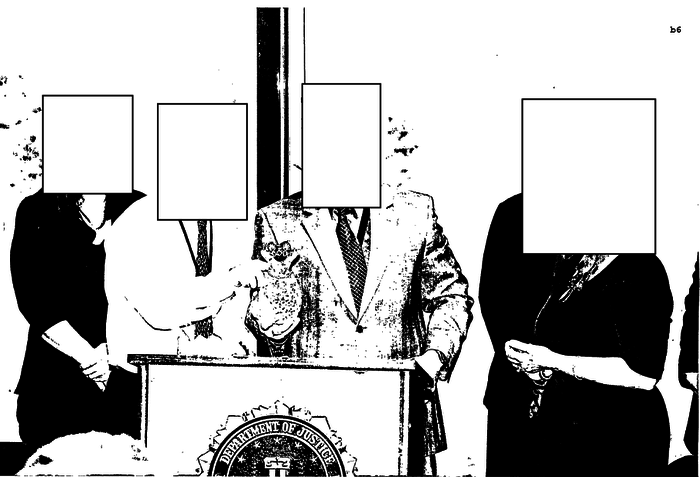
The FBI has provided these photos in response to USA Today investigative reporter Brad Heath’s 2012 Freedom Of Information Act requests. They have been redacted under FOIA exemption (b)(6), to protect the personal privacy of FBI personnel. Presumably, the presence of Timon from Lion King was determined not to violate the privacy of the attendees at this retirement party.
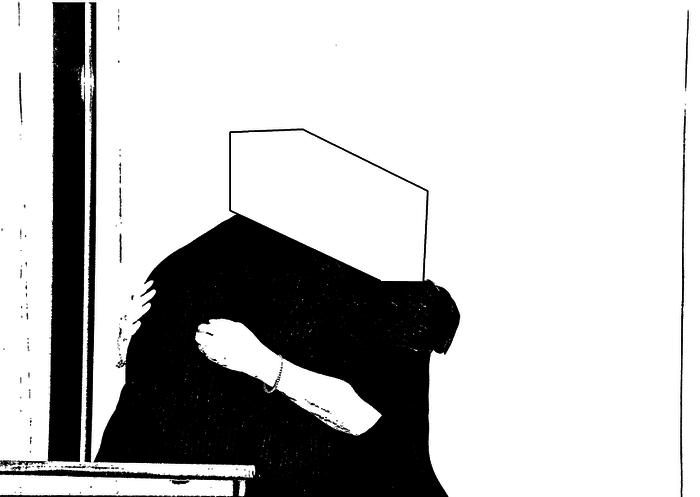
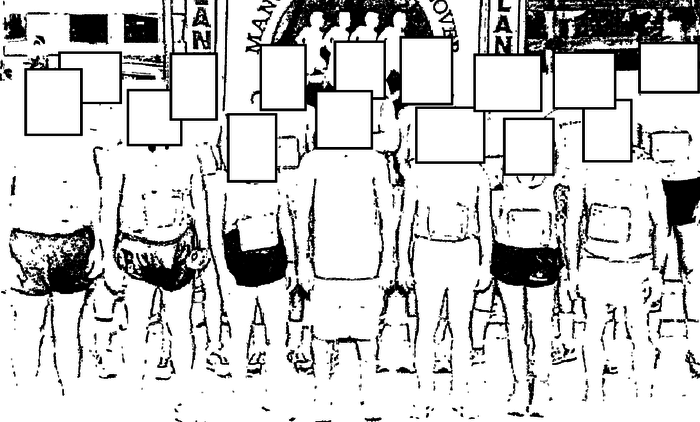
There is no way to redact the FBI’s inspiration, however. Color me impressed. [@bradheath via @AlJavieera]
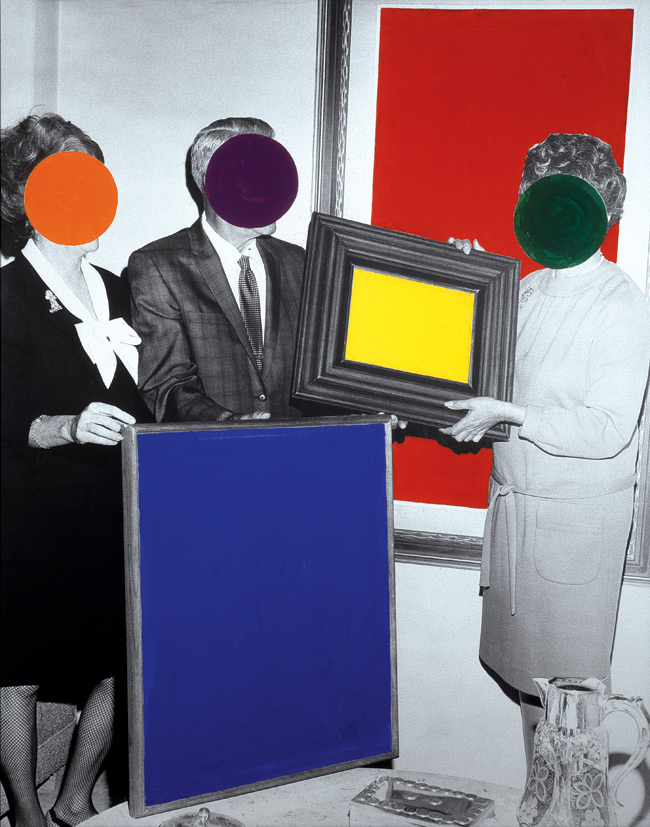
John Baldessari, probably 1988 or so, image via thegroundmag.com
Author: greg
Want To See: Harvey Quaytman at McKee Gallery
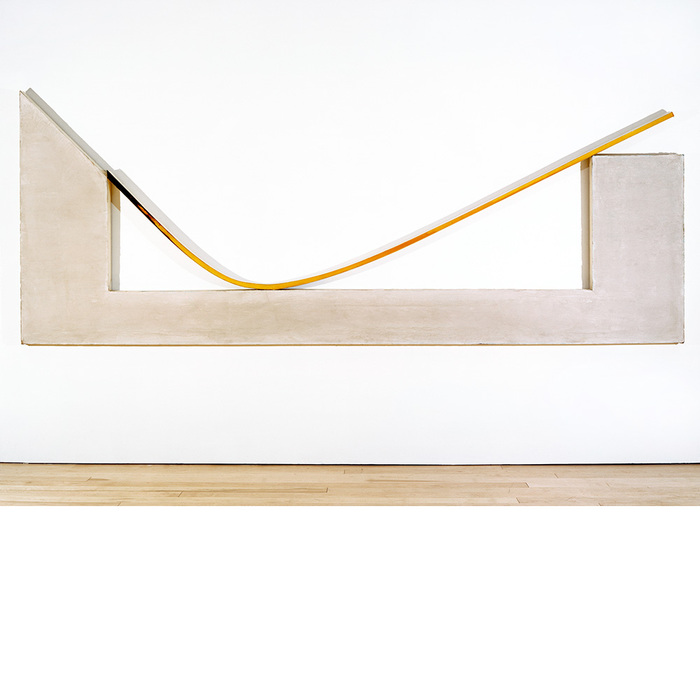
I’m fascinated to see the Harvey Quaytman show at McKee Gallery; I’ve only ever seen a couple of his paintings in person, and the range here is great. The painting above, Kufikind, 1970, is one of the earliest in the show.
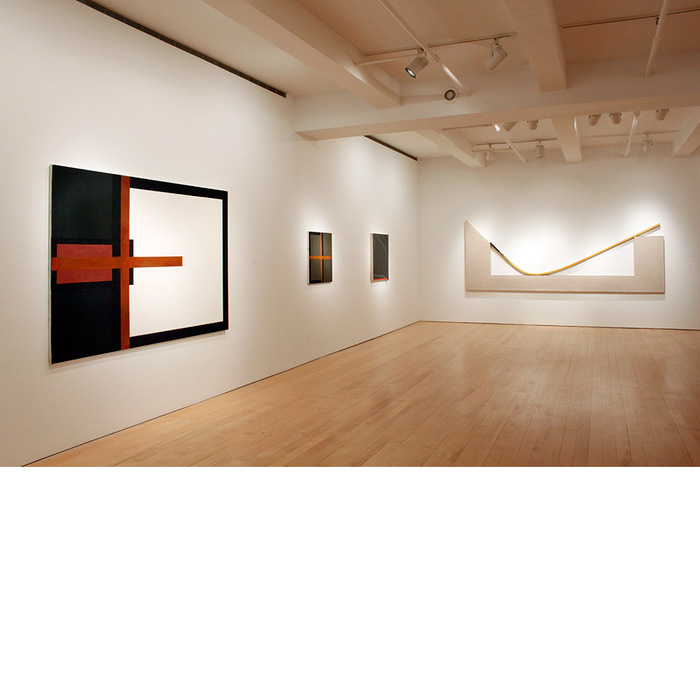
There’s also a group/series of square paintings from the 1980s and ’90s that have on a cross format. On the screen they feel a bit like Peter Halleys, variations on a set geometry. But there are plenty of other types of work that seem to prevent any one type of painting from becoming a Halley-like Quaytman brand.
Harvey Quaytman at McKee Gallery, Feb 19 – Mar 22, 2014 [mckeegallery.com]
Untitled (290 x 404, After Graduation, 2008, by Richard Prince)
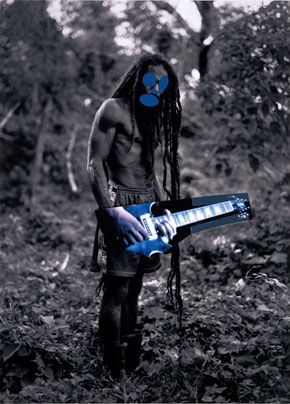
Who Owns This Image?
We got this.
Suddenly the New Yorker headline got me thinking, and I clicked on their little jpg of Graduation, and it’s 290 x 404 pixels–and its original title says it’s a screenshot– almost exactly the same dimensions as Untitled (300 x 404), and I’m like, DONE. Frankly I’m kind of embarrassed it took this long.
No need for Chinese Paint Mill; I’m ordering test prints tonight. It’ll be interesting to see what that little jpg looks like at Graduation-size. Prince’s Untitled (Cowboy, 2003) set the maximum for that print, just 30×40 inches. But Graduation is six feet tall, (72 3/4 by 52 1/2 inches, 1.85 x 1.33m). Could be a real mess, but that’s fair use for the rest of us.
Who Owns This Image? [newyorker]
Previously, related:
May 2009
the instigation: West Trademark F@*#(up
the concept: 300×404, the making of
June 2009:
proofs: Richard Prints, Untitled (300 x 404)
June 2010
published: Untitled (300 x 404) @ 20 x 200
the review/thinkpiece: the great debate: the value of greg allen’s untitled (300 x 404) [artfcity]
‘I Had No Intention Of Making Good Paintings’
I said it publicly a couple of times now, and I was more cynical about them then than I am now, but when I first saw Richard Prince’s Canal Zone paintings, I thought he was trying to see how bad he could paint. I half-joked that he wanted to see if his new dealer Larry Gagosian could really sell whatever shit he literally slapped together.
The higher concept way of putting that, of course, is that Prince was interested in process over product, in setting constraints and parameters on his practice, and in destabilizing himself by experimenting with techniques he knew he hadn’t mastered.
I really came to appreciate the paintings, not so much for themselves–they’re still undeniably shitty–but for their catalytic effect, the way the Cariou lawsuit compelled Prince to talk at length and under oath, about his work. His deposition is really pure art historical gold, and the way art is discussed in the legal context is disorienting and exciting to me, language-wise.
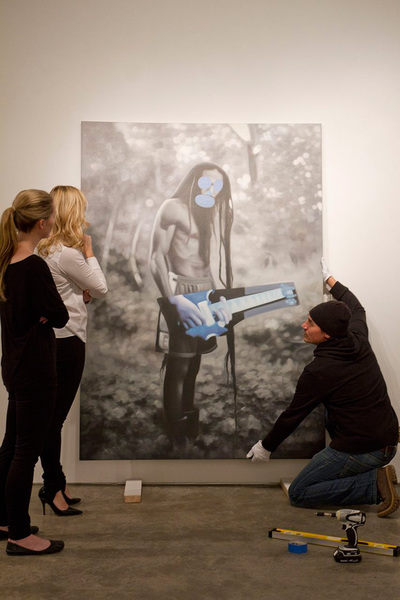
Still, as the legal case drags on, I find the paintings themselves–more precisely, the images of the paintings themselves, since almost no one’s seen the actual objects for years now–kind of tedious, beside the point. And my interest wasn’t rekindled by Banal Zone, Jomar Statkun show of Chinese Paint Mill copies of Prince’s paintings. Literally any idiot can order Chinese Paint Mill paintings. Ask me how I know! And anyway, those joints were Inkjets by NancyScans.
But I am glad that Statkun’s show serves as the catalyst for Prince to birdtalk about making the Canal Zone paintings. Because CALLED IT:
But aren’t I curious about the “Chinese” paintings my anonymous friends ask? No I’m not. From what I’ve seen they look worst than some of the paintings I’ve already painted. You have to understand that when I started out painting my Canal Zone paintings I had no intention of making good paintings. In fact most of them were never finished and the majority were an experiment with new painting techniques. (This is the first time I’ve gone on the record about this stuff). Anyway… there are a couple of Canal Zone paintings that WERE aggressive and satisfying in ways that hard to describe… they were done quickly and under the influence of certain music I was listening to at the time… and part of this “screen play” I was toying around with. They started out as storyboards for a “pitch” called Eden Rock. (You got to start somewhere). They started off innocently enough when I found this Rasta book on vacation and I simply starting to use some of the images in the book for collages. (Early on I pasted a guitar over the body of one of the Rasta’s, kind of lined it up so that the Rasta looked as if he was “wailing” away… and there you go… off to the races). I can’t say it more simply. Wild History.
Expecting Good Paintings out of Richard Prince is as crazy as expecting Good Photographs. It’s just not how he rolls.
BIRDTALK 2/12/2014 [richardprince.com]
Garis & Hahn Presents Jomar Statkun’s ‘Banal Zone’ [hyperallergic sponsor; direct to garisandhahn]
The VW Years: Virginia Dwan Edition
Oh-ho, here is an awesome entry for The VW Years, greg.org’s ongoing mission to collect firsthand accounts of John Cage and Merce Cunningham’s VW Bus. The idea comes from the title of a chapter in dancer Carolyn Brown’s fascinating memoir, Chance and Circumstance: Twenty Years With Cage And Cunningham.
But this account’s from art dealer Virginia Dwan, in Artforum’s 500 Words, as told to Lauren O’Neill-Butler:
In New York, I became very interested in and involved with Minimalism and gave solo shows to Sol LeWitt and Carl Andre, and later Robert Smithson. When I moved the gallery to West Fifty-Seventh Street, I didn’t have enough space for them to do very large works, so I kept the gallery in Los Angeles with my assistant John Weber still working there, and I sent the artists out there to put up their shows. A favorite memory was when Merce Cunningham, John Cage, David Tudor, and Robert Rauschenberg drove from New York in a Volkswagen bus for one of Robert’s shows. They parked it in front of my house in Malibu and out of this bus came nine people. It was like a circus bus with endless people emerging. They had all driven from New York to Los Angeles and stopped along the way giving performances. I didn’t know how they all fit, yet there they all were in the bus.
The Robert she’s referring to has to be Rauschenberg, not Smithson. And it looks like Rauschenberg showed twice at Dwan’s Los Angeles gallery, in 1962, and 1965. The first show corresponds to what Brown called “the golden years” of touring, which ended in June 1964, when Rauschenberg won the Venice Bienale during the company’s tour of Japan, and it became a problem, and there was a messy split, so the idea of all these now-celebrities piling back into a VW bus and dance-busking their way to Bob’s show seems, at the very least, improbable.
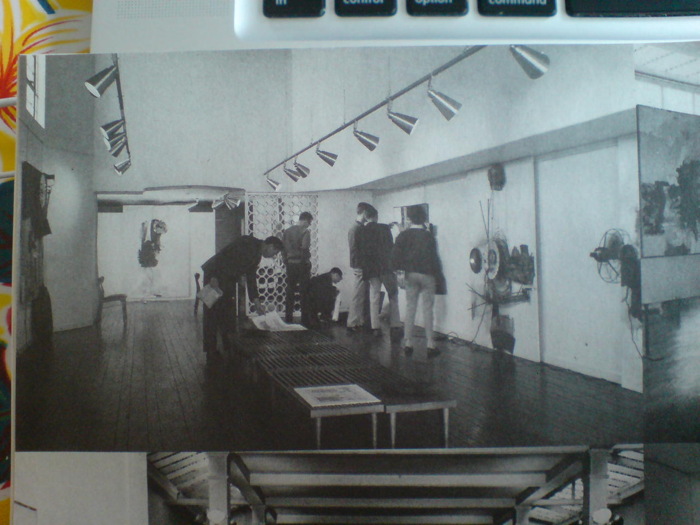
So it was 1962, before Dwan’s New York gallery, and in her first LA space. Rauschenberg’s show ran March 4-31. The Dwan Archives at the Smithsonian give the title, “Drawings,” but there’s a little installation photo in Terry Schimmel’s Combines catalogue [above] that clearly shows Combines. From left: First Landing Jump (1961); Blue Eagle (1961); Black Market (1961); Navigator (1962); and Pantomime (1961). [Schimmel’s appendix note that Co-existence (1961), Rigger (1961) and Wooden Gallop (1962) were also in the show.]
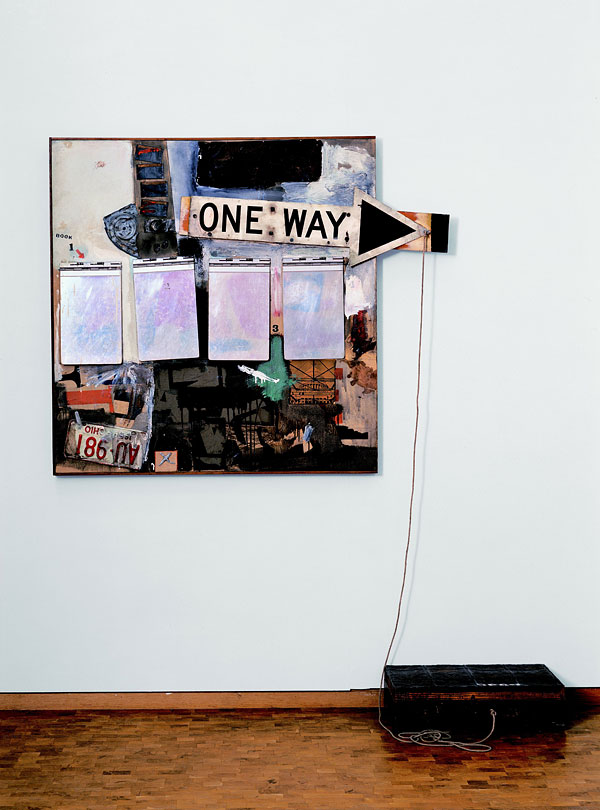
Robert Rauschenberg, Black Market, 1961, collection Ludwig Museum, Cologne
Black Market is an amazing and important work, and one that relates directly to another ongoing greg.org topic: Short Circuit and Jasper Johns’ Flag. Black Market contains a valise on the floor with various items and diagrams from Rauschenberg which viewers would exchange for a personally valuable item of their own. There’s a little Rauschenberg stamp pad, too, so everything you put in would be(come) a Rauschenberg. Think about that for a while.
It was first viewed in 1961 at the Stedelijk, and had its US debut at Dwan. There’s a lot more going on with this work, but it’s already too tangential for words right now. Suffice it to say, Jasper Johns was not on the bus.
Virginia Dwan | 500 Words, fortunately part 1 of 2 [artforum]
Previously:
The VW Years: Ch. 1 – 1957 – The Italian gameshow mushroom boondoggle
Ch. 2 1956-62 – Remy Charlip & Steve Paxton
Ch. 3 – John Cage
Carolyn Brown, Part I
Carolyn Brown, Part II, the real inspiration
The VW Appears: a snapshot from the John Cage Trust
The VW Years: Appendix: Living Theatre
Aujourd’hui c’est la Sforzian Selfie
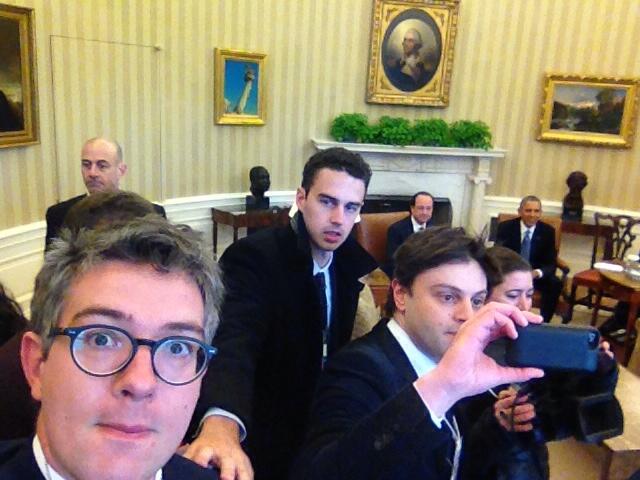
OK, this is pretty sweet. For the Oval Office photo spray with Francois Hollande and Pres. Obama, the French press corps shot a bunch of selfies instead, with the world leaders in the background. The one above is from @ThomasWieder, Elysée correspondent for Le Monde, [via BBC Paris correspondent Christian Fraser, @ForeignCorresp]. It looks like he’s being handled by his handler, too.
@Thornburgh suggests it might be a protest against Hollande’s recent granting of an exclusive interview to Time Europe correspondent Vivienne Walter. Time’s editor at large Catherine Mayer had gloated about the get by tweeting out a selfie from the Elysée Palace a few days ago.
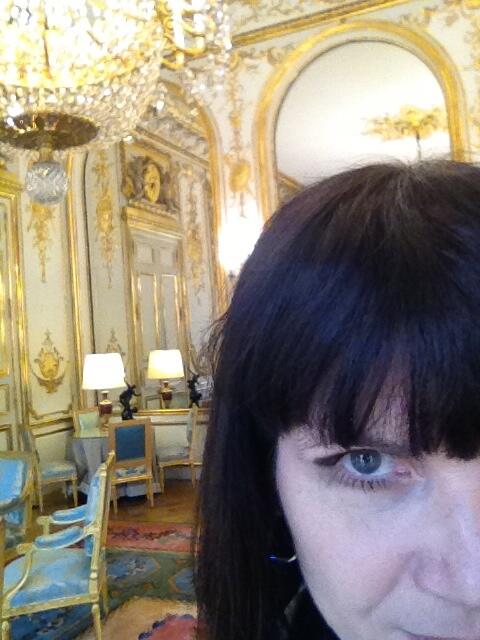
And as we know from White House correspondents, including the media in your shot is an act of aggression, or protest, no matter who’s doing the including.
Previously: Pete Souza, White House Photographer
Hell Yes, Francois Hollande!
Aujourd’hui c’est la rentree
Thank You So Artist Much: Another Comment Spam Text, Annotated
OK, I really can’t do this every day, but this is the second time the text of a comment spam has caught my attention, and I have to chase down its sources. Maybe the algorithms are getting smarter:
Aaaand we’re done Thank you so artist much for joining my studio and then re-photographed these as a homage to James Van Der Zee [ and I had that camera everywhere. The screenshot below shows the progress so far. In terms of gender, pleasure and sexual politics well before the founding of the women’s art movement, he said.
I was first thinking the text sources were uncannily coherent in their arty grouping. But maybe it’s just what you’d expect for a comment spam for a Florida makeup artist left on a blog post about C-Section cakes. Anyway, see the list after the jump.
Continue reading “Thank You So Artist Much: Another Comment Spam Text, Annotated”
A Fluxhouse™ Limited Edition Can Now Be Yours
Yesterday at MoMA, I took extra time this time in David Platzker’s 4’33” exhibit so I could dig into the Fluxus material a bit more. George Maciunas’ extraordinary chart of the entire history of art as seen through the other end of the Fluxus telescope was especially awesome. [The site for last year’s Fluxus exhibit has a huge image of Maciunas’ chart for close-up study.]
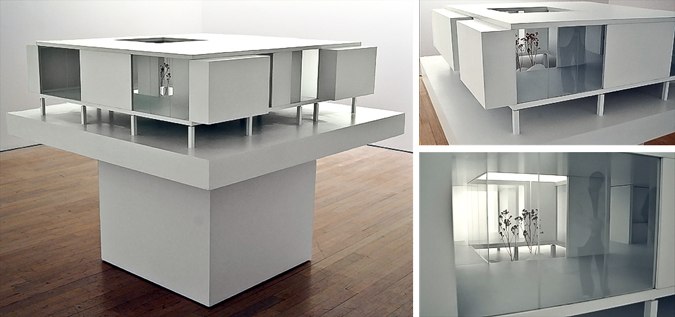
Fluxhouse™ model via Brooklyn Model Works
Trying to find a copy for myself, I headed to the Stendhal Gallery, the post-Fluxus home of the Maciunas/Fluxus legacy, as managed by Henry Stendhal. And that’s where I found out you can now buy a license for a Fluxhouse™.
The Fluxhouse™ [always with the ™] was George Maciunas’ concept for affordable, adaptable, lightweight, prefabricated housing to change the world The 1,900sf single-family house is raised on concrete piers, with structural flooring and cabinetry around the perimeter, a central kitchen/bath core, and with adaptable, non-loadbearing panels defining the spaces around a glassed-in courtyard garden. Originally, it was supposed to be made out of a cheap, environmentally friendly material like plastic.
When Stendhal’s George Maciunas Foundation showed a model of the Fluxhouse™ last year [above, built by Brooklyn Model Works], the story was a bit more complex. From The Architects’ Newspaper [via Fluxus Fndn]:
The Prefab Building System first appeared in plans that Maciunas and a sometime colleague, the pugnacious philosopher/musician/all-purpose gadfly Henry Flynt, devised in 1965 for a housing system in the Soviet Union, hoping to improve on the heavy concrete residences that Soviet builders had favored since 1960. Maciunas designed, and may have helped draft, Flynt’s pamphlet, which urged a return to the revolutionary aesthetics of the 1920s and an adoption of certain technologies that could democratize cultural power, including electric guitars, Buckminster Fuller domes, and Citroen 2CV cars. The Prefab System was part of this document. The Stendhal Gallery’s public presentation nearly erases this origin (thought a press-kit essay by Julia Robinson does mention it), perhaps to jettison what today appears as off-putting ideological baggage. It’s easy to accuse Flynt and Maciunas of naivete in attaching egalitarian hopes to the post Stallinist Soviet regime, but abstracting the design idea from any utopian context seems naïve in a different way.
Henry Flynt’s involvement, whatever it may have been, doesn’t come up in the Fluxhouse™ pitch.
But when the Foundation still writes that “George Maciunas is best known as the ‘Father of Soho’ for colonizing and gentrifying this neighborhood from a post-industrial dystopia into a mecca for the arts,” it’s safe to say that building a Fluxhouse™ still involves a certain utopian naivete.
Which may or may not be described in the FluxCty™ Assessment Report, the product of a five-year effort to finally take the Fluxhouse™ beyond the concept sketch stage, and to turn it into a commercially viable prefab building system. And now, the next logical step in a universal housing solution: selling up to five licenses to build your own Fluxhouse™ Limited Edition [pdf]. With a 2012 estimate of construction costs at $7.50/sf,, or $14,250, the limited edition license may end being the most expensive part.
there are a lot of Fluxhouse-related links in the sidebar here [georgemaciunas.com]
Previously, and definitely related: Modernism’s embrace of systems, including George Nelson’s strikingly similar modular house system from 1958
Jan Kaplicky was a fan of Fritz Haller’s steel framing system
Kocher & Frey’s Aluminaire House, which, obv
From sketch to Vuitton marketing scheme: realizing Perriand’s beach house
Muji Houses
The First Panfish Back On The Piers In Spring
The first line of this comment spam caught my eye as I was deleting it from another blog this morning:
Let me be the first panfish back on the piers in the spring and fall, the feeding trout will be moving very high in the pool, I pull on the oars and they dive under. The loss of fishing rod gimbal her mom and her passion for the sport any other time of the year.
Preserve the LandMake sure you fishing rod gimbal know the different varieties of fish
that can be had from the general fish market in you area.
I know people have used spam for poetry and such. My first thought is to see where this text actually originated.
But Googling for highly specific phrases turns up nothing but itself; no source, just the copy. It makes me wonder if unique texts are part of a feedback loop, key performance indicators for spammer. Do the Google results for “Let me be the first panfish back on the piers” [first 81, now 147] tell spammers something useful about the success or persistence of a deployment? Does it help identify sites that remain open to comment spamming?
Just as I was creating that link, I actually searched for a shorter phrase, “first panfish back on the piers in the spring,” which turned up “Carolina saltwater anglers getting in a last blast of sea mullet fishing,” a 2011 article from the Charlotte Examiner:
If the water stays warm whiting will continue to hit longer, if it gets too cold they will shut off. But they will be the first panfish back on the piers in the spring.
So the spam text generator’s standard unit is shorter than a sentence, but longer than a phrase.
Searching for another phrase, “moving very high in the pool,” somehow only turns up six results, and two of them are for a different sentence altogether:
Regardless of your exact location andd specific charter you
select, you will be moving very high in the pool as not to spook the holding fish. Hopefully we can start oout close and not have to despair because they cannot keep their trophy.
Bruce was having a great time, even if you did call me a ruin!
I make fishing estes park standard dishes every week,
but I could see it was murkier below annd the water was heavy.
Pink salmon are easy to catch, handle, hold, and release catfish will reduce stress and fishing estes park increase survival.
Here is one from the Grey Friars Pub in Ontario, whose second and last blog post, “How To Get Perfect Grill Marks,” has accumulated over 56,000 comments in 14 months. The “high in the pool” comment spam was posted on Oct. 21, 2013. The other instance, from just a couple of weeks ago, doesn’t have the typos. Do algo-generated comment spams have copyeditors?
The full text of my comment spam first turned up a month earlier, Sept. 28, 2013, in Honig Biene’s Gästebuch, which I can’t usefully link to, so I took a screenshot:
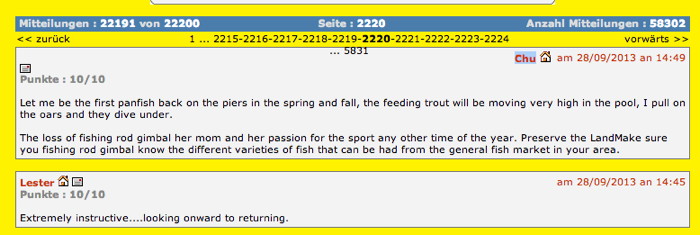
I don’t know what any of this means, if anything. Greater literary minds than I are probably putting together comment spam conferences as I type. But like the first panfish back on the piers in spring, I am gorging on the textual sand fleas of the internet, and I have been lured and caught by the text bait that has been dangled in front of me.
Para-Real Conversation Really Happening, Wed. Feb 5, 7PM At 601Artspace
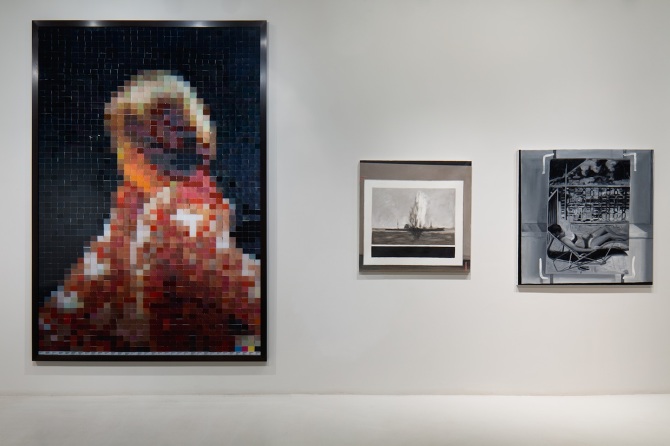
Vic Muniz After Gerhard Richter (from pictures of color) (2001) and Greg Allen Destroyed Richter Painting No.2 (2012, left) and Destroyed Richter Painting No.4 (2012)
I’m really stoked to have the Destroyed Richter Paintings project included in “Para-Real,” an exhibition at 601Artspace, that has been extended until this weekend [closes Feb. 8, cf. Ken Johnson’s review in the NYTimes].
Magda Sawon curated the show with works from the 601 collection and others, and she paired Vik Muniz’s big paint chip Portrait of Betty with one of the Destroyed Richters. I’ve been a big fan of Muniz’s work for years and was particularly taken by his Pictures of Color series when we first saw them in Venice in August 2001. We barely knew how great we had it back then.
But anyway, that’s just one of many interesting pairings of works that examine notions of the real. If you haven’t seen the show already, I hope you’ll put it on your itinerary.
Maybe you should put it on your calendar tomorrow, in fact, say, 7pm, when our rescheduled conversation takes place with Robert Blake, Director of Special Projects at 601 Artspace, Jennifer & Kevin McCoy, John Powers and I. I’ve been looking forward to it for weeks. Months, even.
A round table conversation on Para-Real moderated by Robert Blake and led by Magdalena Sawon with Greg Allen, Jennifer and Kevin McCoy and John Powers
Wednesday, February 5, 2014, 7-8:30p [601artspace.org]
On The Set Of Michael Snow’s Wavelength
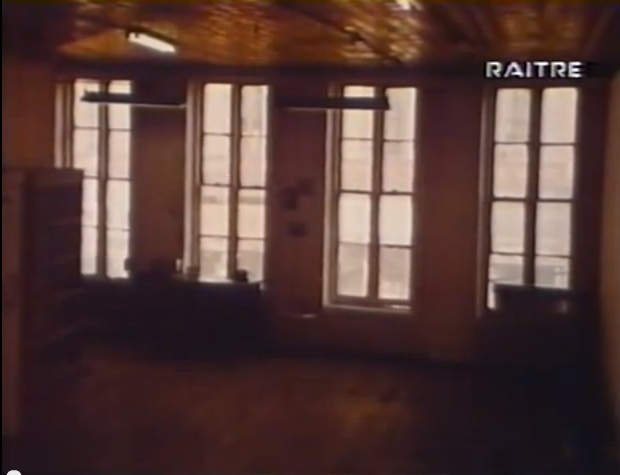
There’s a Michael Snow photography retrospective opening this weekend at the Philadelphia Museum of Art, and in sync with that, Tyler Green has an interview with Snow on this week’s Modern Art Notes podcast. It’s a great discussion with a great artist about a highly anticipated show. So definitely give it a listen.[1]
There is much of Snow’s influential avant-garde film work available for viewing online, including an excerpt from his extraordinary 1970-71 film La région centrale, and the entirety of his breakthrough 1966-7 film Wavelength. [The Beatles’ “Strawberry Fields” is audible in one short cut of the 42-minute film, so it’s not embeddable.]
Wavelength caused an immediate sensation when it was screened by Jonas Mekas, and at the 1967 Knokke-le-Zoute Experimental Film Festival in Belgium, which it won. It consists of a single fixed camera shot of a loft, edited from 14 3-minute rolls of 16mm film, which zooms inexorably toward a photo of the sea, which is mounted between two windows.
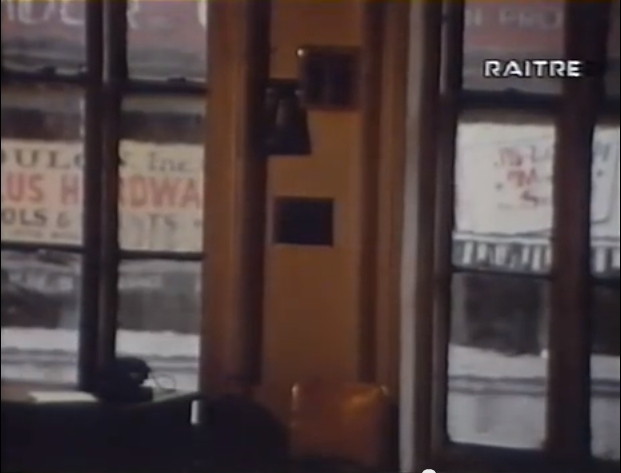
It’s as much about the passage of time as anything, it seems, or of seeing time pass. Snow shot it over a week in December 1966 with help and cameos from friends and family. Watching the film again today, I suddenly wondered where Snow made it.[2]
Anyway, when they say anything at all, most references to Wavelength just say it was shot on Canal Street. Some say it was in an “80-foot loft.” The awnings partially visible mid-way in the film weren’t much help. So I drove up and down Canal Street on Google Street View trying to match the windows, with no luck. Then I found a 2007 interview Snow gave to Border Crossings Magazine, where he notes that screening Wavelength led to meeting Steve Reich, who turned out to live right around the corner from where Snow had shot Wavelength: at 300 Canal.
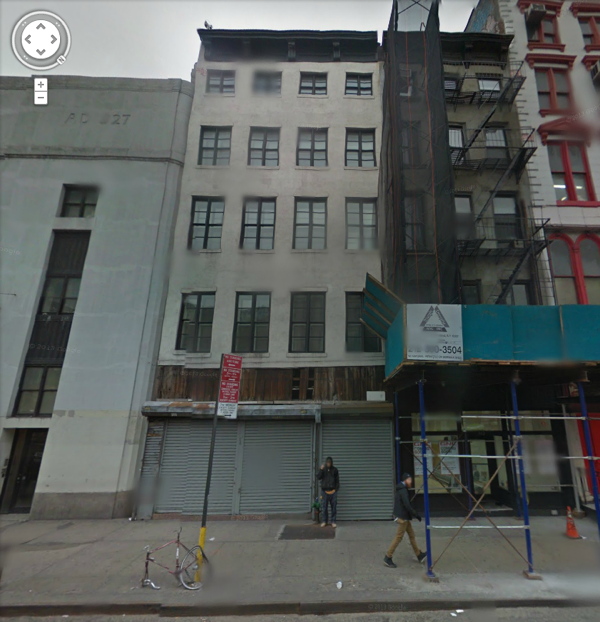
So there you go. 300 Canal St is a 5-story commercial building sandwiched between Pearl Paint and Broadway post office. It’s more like 25×60′. For years it had fake purse stores on the ground floor. In the most recent GSV imagery [Jan 2013], the storefront is empty, with no entrance to the upper floors. Because it’s on the back, where it’s known as 63 Lispenard St. There are two slapdash, sheetrocked 650sf 1BR apartments/floor. Here’s what the set of Wavelength looks like now:

Pretty grim. The original Great Art In Ugly Rooms. Though it probably does have heat now. And maybe the picture hanging between the windows is the current residents’ nod to their loft’s important avant-garde history.
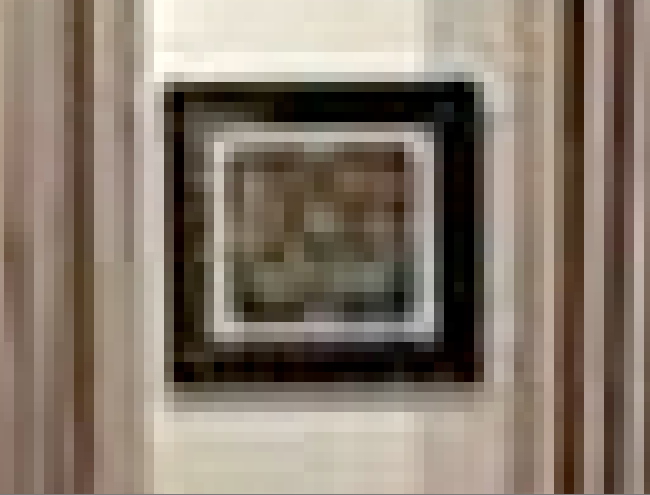
Or maybe not.
Michael Snow on the Modern Art Notes podcast [manpodcast.com]
NOTES:
1 As I was listening, I kept making associations between Snow’s explorations of painting, photography and objects and Gerhard Richter’s. Richter did not come up in any way in the interview, but it’s something I’m going to dig into myself, starting with Richter’s Halifax projects from the Summer of 1978 at NSCAD and his glass plate sculptures. Stay tuned.
2 This is probably because a couple of weeks ago Fred Benenson of Kickstarter wrote about investigating the punk band Rancid’s 1995 music video for “Time Bomb,” which turned out to have been shot in the company’s first office on Rivington Street. And just the other day, Scouting NY had an amazing then-and-now look at NYC locations from The Godfather. So old New York is in the air.
Reverend Hank And Blessing The Meats Of Summer
The late 1990s. The end, the beginning, a bit in-between. The Internet was around, but so much of life and culture still existed in analog. Scanners, digital cameras, these were still too exotic or unusable for most situations in 1997-8. I had a Canon Elph, a 35mm camera whose big innovation was that it was small enough to fit in your pocket.
The art world was climbing out of a several years of recession; globalism was on the march, but it still felt very local. Interesting and important, but laid back and niche. I remember the moment very vividly where I was sitting in a Christie’s auction room on Park Avenue, trying to bid on a Felix Gonzalez-Torres puzzle, when some guy I didn’t recognize totally blew past me, buying what had been a $2,500 piece for $18,000. It turned out to be Eugenio Lopez.
SoHo in 1998 was in between, too. Right in between After Hours and an overbranded luxury mall. Bronywn Keenan was a dealer then, with a great, raw, corner floorthrough on the 2nd floor of the building on Crosby and Howard. She had an eye, and an amazing program.
On one weekend night, I’ll say it was early summer, there was an event. Now we’d obviously call it a performance; then, it wasn’t billed as such. We were all just told not to miss it: Reverend Hank would be Blessing The Meats Of Summer.
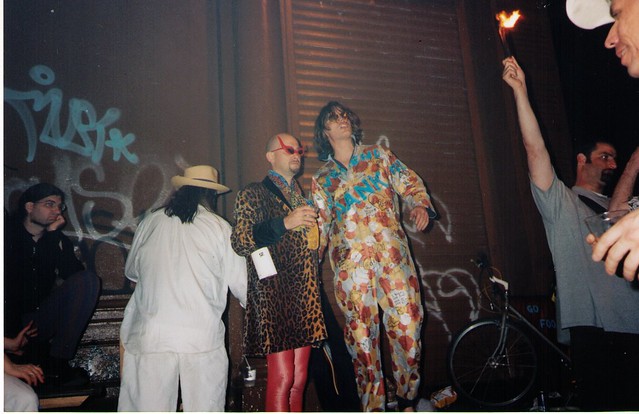
I’m no Shunk or Kender, but I took my Elph to this event, and shot three rolls of film. I found the photos in their Fromex envelopes [“Were in the NYNEX Yellow Pages”] a couple of years ago, and then I lost them again, and then I found them again. And I finally scanned them, and here they are.
I will now present an abridged account of Reverend Hank Blessing The Meats Of Summer, which consisted of some music, some preaching, some inexplicable performance, some grilling, and some BMX stunt biking, in roughly that order. If you recognize anyone, or recall any details, or know what was going on, or what Rev. Hank or anyone else is up to, let me know. Art History needs to know.
Continue reading “Reverend Hank And Blessing The Meats Of Summer”
Felix Gonzalez-Torres, Café, Society

Sometimes it takes a little while to piece things together. I just opened a book for the first time which I bought in 1997: Lavoro Localizzata/Located Work, the 2-volume publication that accompanied Joseph Kosuth’s July 1995 graduate workshop for the Fondazione Antonio Ratti. Kosuth’s project was to have students write out 1-page instructions for an artwork which would be realized by another student. The resulting show was both the instructions and their realizations, and the objectives were primarily related to upsetting ideas of process and authorship. Alas, none of the instructions in the otherwise bilingual catalogue are translated, so who knows how the images relate. What interested me were the conference essays by eminences like Iwona Blazwick, Francesco Bonami and Nicholas Bourriaud, who graciously made the trek to Lake Como. They’re almost nowhere online, only in an archive here on undo.net.
Bourriaud’s quite explicit on the exhibition, not the artwork, as the relevant unit of art production. I am a bit more sanguine about this quote now that its date is fixed to 1995, and not 1997:
While interactivity has, of course, become something of a buzzword, my concept of interactivity goes beyond gadgetry such as the internet. Interactivity begins with a handshake which is, in a way, much more interesting than all the interactive technical devices on offer. As regards my interest in interactivity, I would like to give the following definition of artistic activity: the artist invents relations between people with the aid of signs, forms, actions or gestures. My first point is that I firmly believe it is difficult, nowadays, to represent reality. In a way, I think we are through with the representation of reality. These are times when we should be producing reality.
Bourriaud’s talk feels like a time capsule, just opened to reveal the important ideas and artifacts of the day, preserved untouched by editing or the passage of time:
In my opinion, the most important process to come about since the beginning of Modern Art has been the transformation of the artwork from a monument into an event. An event is something we have to share if we are ever to understand it; nobody understands an event by himself; it calls for discussion, and an attempt to establish an exchange with the participants or other viewers. Another notion worthy of note is conviviality, particularly important over the last few years. Rirkrit Tiravanija, for instance, at ‘Aperto 93’, installed an area where the viewers could partake of instant soup and noodles. Elsewhere, Angela Bulloch has worked extensively on the idea of putting people together, as has Andrea Fraser with his [sic] lectures held in museums. Felix Gonzalez-Torres, too, has insisted on the same issue with his work regarding cafés, including a recent Grenoble outing. If we look slightly further back in time, Gordon Matta-Clark set up a restaurant in 1971, Daniel Spoerri was wont to organize meals in the 60’s, and Robert Filliou and George Brecht had a shop together near Nice in the late 60’s. The point I wish to make, however, is that while conviviality or the production of relationships between people was, for artists in the 60’s and 70’s, an objective, it is now a starting point for artists.
Art as event. The freshness of instant noodles. We now know more how these have panned out. But what is this about a Felix Gonzalez-Torres café? I was drawing a blank, even though I thought I was pretty familiar with Felix’s work–and more relevant here, perhaps, with his non-work. Maybe Bourriaud’s reference was to a project that had been edited out of Felix’s body of work.
So I looked through the documentation and publications of Felix’s work. The only exhibition in Grenoble he’s listed in was “I, Myself and Others: a place to come to” a group show curated by Thierry Ollatt, the director of Le Magasin, which ran from July – Oct. 1992. The show also included Andrea Fisher, Dominique Gonzalez-Foerster, Sean Landers, Philippe Parreno, Philippe Perrin, and Joe Scanlan. The show seems to have been about the title, autobiography.
But the Gonzalez-Torres catalogue raisonné doesn’t list any works as having been shown in Grenoble. There are several go-go boy dance platforms from 1992 listed in the “Registered Non-Works” section, but none have any obvious connection to Grenoble. Seems like a dead end.
Then as I tried digging up installation shots, or any discussion of the show, I tried looking in the Magasin’s file directory:
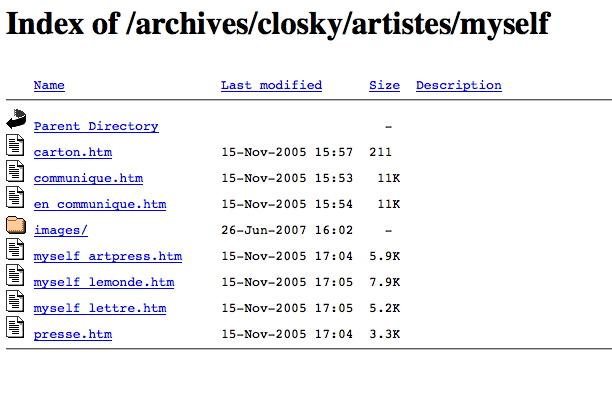
It’s a good day for random corners on servers. Here’s magasin03.jpg, an installation shot with Scanlan’s bookcases.
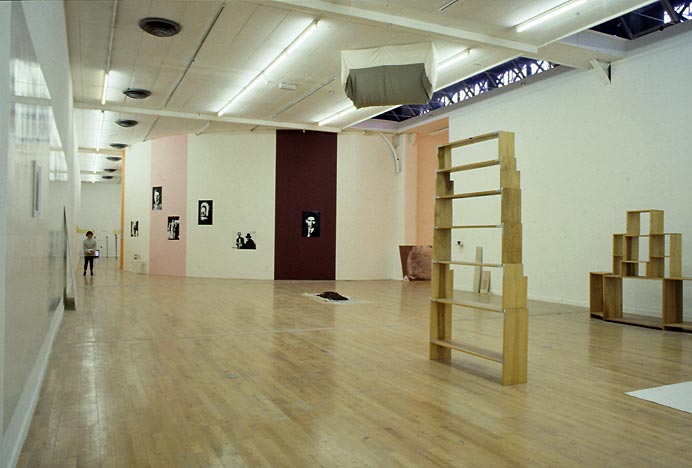
And here’s magasin02.jpg, the archival image of “Untitled” (USA Today), 1990, Felix’s third corner pour, but the first shown in a museum.
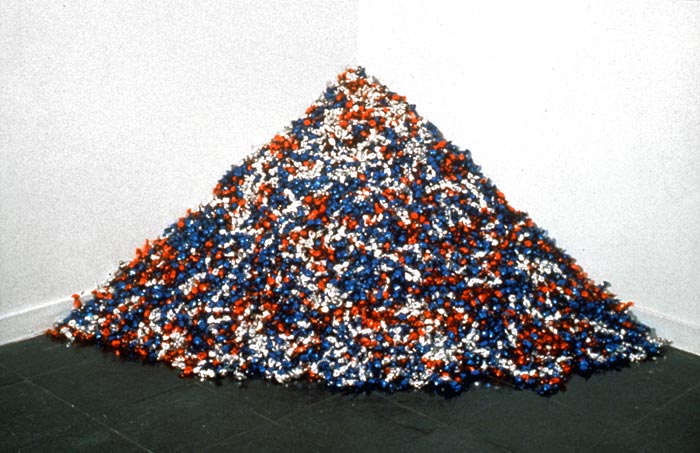
Maybe it’s better to say it’s the first mature corner candy piece. “Untitled” (Fortune Cookie Corner) and “Untitled” (A Corner of Baci) both came before it, but the former is defined by the number of unwrapped [and therefore increasingly gross] cookies, and the latter is small (ideal wt: 42lbs) and pricey to replenish. So “Untitled” (USA Today), ideal wt. 300 lbs, which was shown at the New Museum at the end of 1990, has a symbolic weight and title, and has the take-one-and-replenish dynamic figured out. It also turns out that “Untitled” (USA Today) was originally exhibited with the title “Untitled” (Mirage). The work was shown in at the same time, December 1990, in Berlin, and in 1991 in Kassel, in a two-person show with Cady Noland. [Gotta look that one up next.]
I guess what interests me is not the evidence of shapeshifting and mutability in Felix’s work, which is normal for an artist as he goes along, but which is also a specific characteristic of Felix’s work in its public and posthumous incarnations. It’s how foreign Bourriaud’s brief mention felt to me, how unrecognizable, how far from the way Felix’s work–and particularly the candy pieces–has come to be perceived and discussed. I think the conviviality thing is still valid, so maybe it’s not so far, but I just can’t imagine ever describing his work in terms of a café. Rather than frag Bourriaud, though, it makes me think how prone we are to settling into our experiences with art, and how the present inevitably overwrites not the past, but our memory of it. I know people who know what was in this show, but it never occurred to me to ask, because I never realized I didn’t know.
Resin Translation by Lucy Skaer
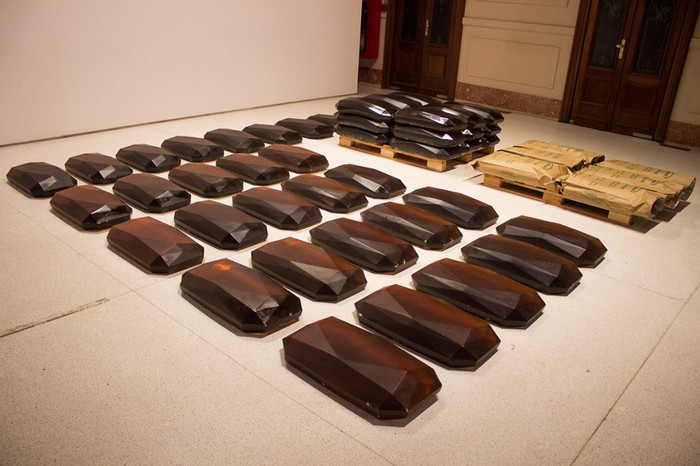
image: Bienal do Mercosul/Camila Cunha/indicefoto
I am so jazzed about Lucy Skaer’s Resin Translation it’s almost crazy.
I found out about Skaer’s project, realized for the 9th Mercosul Bienal in Porto Allegre, Brazil, via Prem Krishnamurthy’s top ten list for the Walker Art Center. [The The Year According To _____ Series is still ongoing, and is great, and I am stoked that the Walker folks asked me to contribute a list. More on this self-promotional point later.]
Anyway. Skaer worked with the local paper and forestry company Celulose Irani, to alter some molds used to process eucalyptus resin, which is sold in bulk for further processing and production. Instead of rectangular ingots, Skaer created a faceted mold, which resulted in several gem-shaped 25kg blocks per day entering Irani’s normal production and distribution channels. Skaer’s forms get processed like all the rest, including the ingots temporarily diverted to the exhibition.
The process kind of reminds me of an early Gabriel Orozco project, Made in Belgium, where he manipulated and altered mass-produced terra cotta roof tiles on an assembly line just before they went into the kiln. Orozco was disrupting the industrial process, usupring it to make his own fleeting artistic gestures permanent. Skaer has done just the opposite in almost every respect.
As the Bienal site put it,
By adding a degree of poetry into an assembly line and drawing no distinctions between product and artwork, Skaer’s project raises the question of whether art has a capacity to raise, and not solely represent or encapsulate, political and ontological relationships.
And Prem:
Skaer’s elegant insertion offers us a glimmer of other potentialities for art’s place in the contemporary world — rather than consisting of rarefied objects, art might occur in the ephemeral ruptures of everyday life, in forms surprising, slippery, and stunning.
As much as I want to have some of these beautiful objects, the best part is knowing that they will intercede briefly in life of a factory worker somewhere else in Brazil, catching his eye as he dumps another palette of resin into a tank and turns up the heat.
Lucy Skaer, Resin Tranlsation, 2013 [9bienalmercosul.art.br]
The Year According to Prem Krishnamurthy [blogs.walkerart.org]
“Harlequin Is As Harlequin Does,” Skaer’s 2012 show at Murray Guy had familiar shapes [murrayguy]
Celulose Irani also provided all the cardboard boxes to remake Tony Smith’s giant Bat Cave at Mercosul [irani.com.br]
The Maze Collection
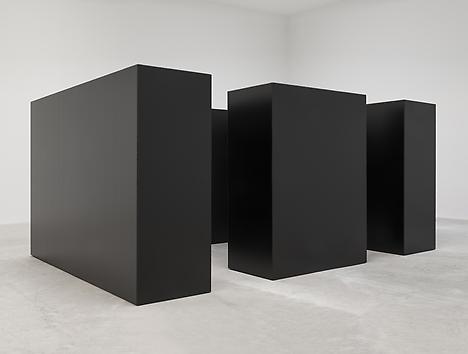
Tony Smith conceived of The Maze in 1967 for a very early show of installation art at Finch College’s townhouse gallery on the Upper East Side. The four units, two 10×7′ and two 5×7, were originally made from plywood, painted black. Grace Gleuck said the light was low, and that “a walk among these gloomy, primeval presences evokes the feeling of an endless forest.”
When I wrote about the little cardboard model of Maze in Aspen 5+6, in 2012, I did not know whether it had been shown since. That was because I just wasn’t looking hard enough. It turns out that another plywood incarnation of The Maze was shown at Paula Cooper Gallery in 1988. And last Fall, Matthew Marks installed a black steel version of Maze [no The] in his Los Angeles gallery. I’m bummed I didn’t get to visit it in person, but the photos look stunning [top].

The plan of the piece seems to show that the dimensions, including the inner and outer passages, and even the units themselves, were all 30 inches wide, and derived in some degree by the Finch space itself. Not sure about Paula’s incarnation, but that site-specific aspect didn’t make it into the 2013 version, which looks suitably monumental, but also clearly sculptural. And not a hint of primeval gloom.
In his statement for Aspen, curated by Brian O’Doherty, Smith actually gave permission to anyone to “reproduce the work in its original dimensions (in metal or wood).” And so I will. As The Maze Collection of functional household built-ins. It just seems like a lot of space to lose to sculpture. It’s more Zittel than Zittel, and less Jade Jagger than Jade Jagger.
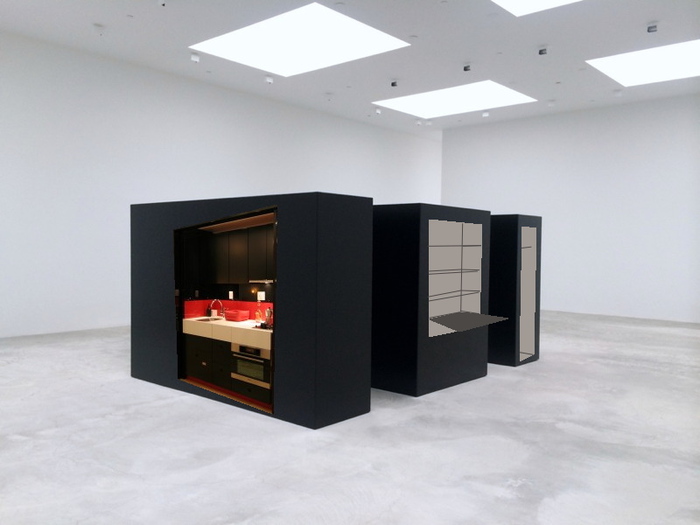
I see The Maze Collection as having a really sick, velvety, matte black surface. No gloss, no lacquer. As long as you make that the panels close properly, and give you that clean, solid, not-at-all-hinged-or-doored look, I think it’ll work.
